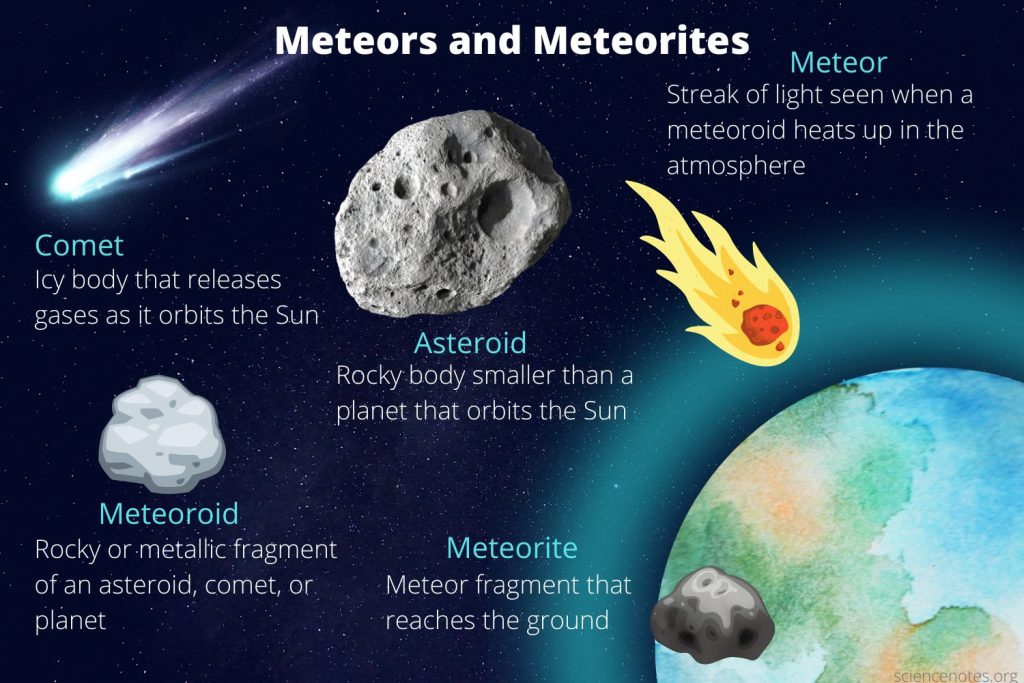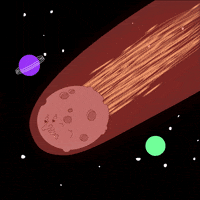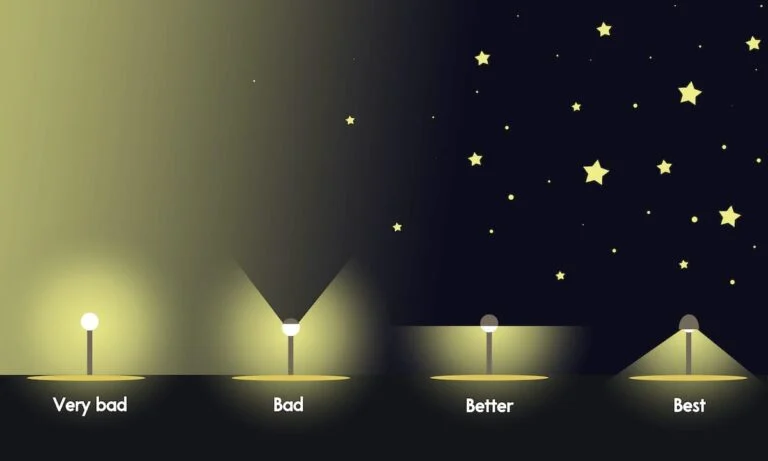Starry Surprise: A Guide to Exploring Meteor Showers
You and your friends decide to sleep outside under the stars. When you notice several bright lights zipping across the night sky. What are those bright lights? Is it a satellite? No! A spaceship? Nope! It is a meteor shower!
A meteor shower is many meteors traveling through the Earth’s atmosphere. When Earth rotates around the sun passing through a comet or asteroid orbit, a meteor shower occurs.
Meteoroid v. Meteor v. Meteorite
- Meteoroid is an object ranging in size from dust particles to small asteroids
- Meteor is a the light coming from the meteoroid as it enters the Earth’s atmosphere
- Meteorite is a meteoroid that goes through the atmosphere and hits the Earth’s (or other planets) ground

A meteoroid forms from either pieces of asteroids or comets. Most of the meteoroids we see are pieces of comets – that lose gas or dust when they travel towards the Sun.
In the atmosphere, tiny pieces of asteroids or comets (about the size of a grain of rice) break off and fall towards the Earth’s surface at a fast rate. A meteoroids speed ranges from roughly 25,000 mph to 160,000 mph.

But WAIT…
No need to worry! Because of the size and speed, meteors burn off before ever reaching the Earth’s surface.
Fun Fact: Did you know we call meteors shooting stars or falling stars? But they are NOT stars at all. We call meteors stars because of the bright light created as they travel through the sky.
Estimate the Size
Want to estimate the meteor size when viewing the meteor shower? Easy!
You can tell the size by how long the tail light from the meteor stays in the sky. The smaller the meteor the quicker the light disappears. The larger the meteor the longer the light stays in the sky.
A Meteor By Any Other Name
Scientists have a unique, yet simple way they have named meteor showers, they use constellations. For example, Leonids Meteor Shower (Nov.16-17) occurs near the constellation Leo. The meteors radiant point is present in the Leo constellation during peak conditions.
Here is more information about meteors, meteoroids, asteroids,etc.
Now that you know more about these cosmic light shows. Here are 6 tips to help you enjoy a meteor shower:
- Understand the Meteor Event
Meteor watching is always a fun activity. Though it can be disappointing, if you do not understand what is happening. It is always important to research before viewing anything science related.
You should search the peak time, the moon phases and the ZHR (Zenithal Hourly Rate) of the particular meteor shower event.
| Date of Peak | Shower Name | City/Rural Sky with Full Moon | Suburb/Rural Sky with Quarter Moon | Rural sky and NO Moon | ZHR |
|---|---|---|---|---|---|
| January 3-4 | Quadrantids | 5 meteors | 10 meteors | 25 meteors | 120 meteors |
| April 21-22 | April Lyrids | 3 meteors | 5 meteors | 10 meteors | 18 meteors |
| May 4-5 | Eta Aquarids | 3 meteors | 5 meteors | 10 meteors | 60 meteors |
| July 28-29 | Delta Aquarids | 3 meteors | 5 meteors | 10 meteors | 20 meteors |
| August 12-13 | Perseids | 10 meteors | 20 meteors | 50 meteors | 100 meteors |
| October 21-22 | Orionids | 5 meteors | 10 meteors | 15 meteors | 23 meteors |
| November 3-13 | Taurids | 1 meteor | 2 meteors | 3 meteors | 5 meteors |
| November 16-17 | Leonids | 3 meteors | 5 meteors | 10 meteors | 20 meteors |
| December 13-14 | Geminids | 20 meteors | 50 meteors | 75 meteors | 120 meteors |
| December 21-22 | Ursids | 1 meteor | 2 meteors | 5 meteors | 10 meteors |
Here is a list of the current and future meteor shower events for 2023-2024
- Make sure it is a dark and clear night
The perfect area to view a meteor shower is away from city lights, perhaps in a wide open field. You also want to be away from the moon. Moonlight can make it difficult to see the meteors.
Even though meteors are bright, any other competing light will obscure the night sky. So try to go out when there is very little moon light and no city light pollution.

- Grab a sleeping bag, snacks and a buddy
What is better than viewing the night sky with friends or family? Nothing! So plan a meteor shower party!
You will be outside for a long time, as most meteor showers don’t occur until after midnight. While you wait, discuss cool facts about meteor showers or other astronomical events. Maybe even play some games, like spot the constellation.
- Divide and Conquer
When looking for meteors, it is hard to predict the exact location. Splitting up will give you and your friends the best chance at watching the meteor shower. Each one should look at a different section of the sky. When someone sees a meteor, have them point and yell “LOOK, METEOR!”
Above is a quick video of the Perseid Meteor Shower.
- Patience is Key
Meteor showers show up in spurts. One minute you spot 6 meteors back-to-back, then you have to wait 10-15 minutes for the next one to appear. It is like whale watching, one moment you might see three whales then none for 20 minutes. Viewing meteors is a patient activity.
- ENJOY!
Meteor shower watching is a fun event that can bring out the astronomer in anybody. Meteor showers occur almost every month, so you can plan a meteor-gazing party at any time!
Remember if you only see 1 or 2 meteors zooming across the night sky or you see 20+ meteors, don’t fret. At least you got to witness an incredible event. And next time you might encounter more.

P.S.
Don’t forget to make a wish when you see a “shooting star.” It might come true!
Vocabulary Builder
- Atmosphere: the gasses that surround Earth or other object in outer space
- Asteroids: small, rock-like bodies that travel around the sun
- Comets: large objects made from ice and dust that travel around the sun
- Constellation: a group of stars, that look like and are named after a person, animal or object
- Radiant Point: The point from which all meteors appear to glow during a meteor shower
- ZHR: Zenithal Hourly Rate is the number of meteors per hour you will see at peak conditions.
